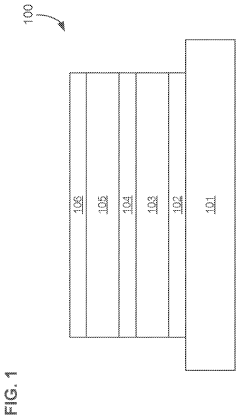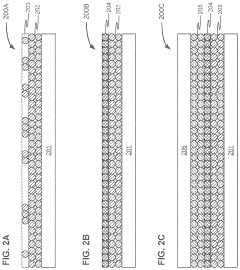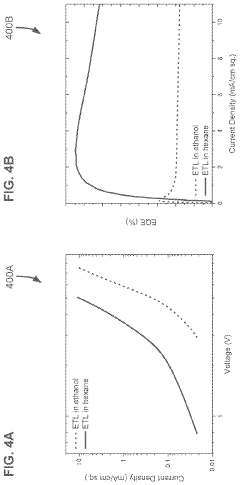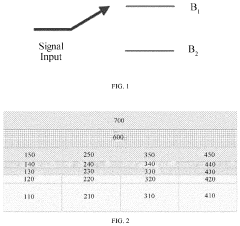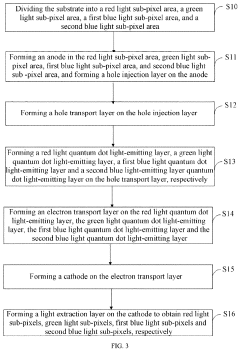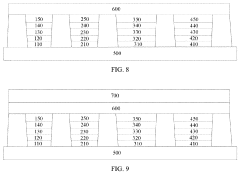QLED Technology: Future Prospects in Interactive Media
QLED Evolution and Objectives
Quantum Dot Light Emitting Diode (QLED) technology has emerged as a revolutionary advancement in display technology, offering superior color accuracy, brightness, and energy efficiency compared to traditional LED and OLED displays. The evolution of QLED technology can be traced back to the early 2000s when researchers first began exploring the potential of quantum dots in display applications.
Initially, quantum dots were primarily used to enhance the color gamut of existing LCD displays. However, as the technology matured, researchers and manufacturers began to envision a future where quantum dots could serve as the primary light-emitting component in displays. This led to the development of QLED technology as we know it today.
The primary objective of QLED technology in the context of interactive media is to create immersive, high-quality visual experiences that push the boundaries of what is possible in digital interaction. As interactive media continues to evolve, encompassing areas such as virtual reality, augmented reality, and mixed reality, QLED technology aims to provide the visual fidelity and responsiveness necessary to create truly compelling and lifelike experiences.
One of the key goals in QLED evolution is to improve the efficiency and longevity of quantum dot emitters. Current QLED displays still rely on a backlight to excite the quantum dots, which limits their potential for true blacks and perfect contrast. Researchers are working towards developing electroluminescent quantum dots that can emit light directly when stimulated by an electric current, potentially rivaling or surpassing OLED technology in terms of picture quality and energy efficiency.
Another important objective is to expand the color gamut and enhance color accuracy. While QLED technology already offers impressive color reproduction, there is ongoing research to develop quantum dots capable of producing an even wider range of colors with greater precision. This is particularly crucial for interactive media applications where color fidelity can significantly impact user experience and immersion.
Durability and stability of quantum dots under various environmental conditions is another area of focus. As interactive media devices become more portable and ubiquitous, QLED displays must be able to maintain their performance characteristics in diverse settings, from bright outdoor environments to temperature-controlled indoor spaces.
Looking towards the future, researchers are exploring the integration of QLED technology with flexible and transparent substrates. This could pave the way for innovative interactive media experiences, such as foldable displays, wearable devices, and augmented reality windows. The goal is to create displays that can seamlessly blend with our physical environment, opening up new possibilities for interactive content delivery and user engagement.
Interactive Media Market Analysis
The interactive media market has experienced significant growth in recent years, driven by technological advancements and changing consumer preferences. This market encompasses a wide range of products and services, including interactive displays, augmented reality (AR), virtual reality (VR), and interactive gaming platforms. The integration of QLED technology into interactive media presents a promising opportunity for market expansion and innovation.
The global interactive media market is projected to continue its upward trajectory, with a compound annual growth rate (CAGR) expected to remain strong over the next five years. This growth is fueled by increasing demand for immersive experiences in entertainment, education, and business sectors. The adoption of QLED technology in interactive displays is anticipated to further accelerate market growth, offering enhanced visual quality and user engagement.
Consumer demand for high-quality, interactive content is a key driver of market expansion. As users seek more engaging and personalized experiences, QLED-powered interactive media solutions are well-positioned to meet these evolving needs. The technology's superior color reproduction, brightness, and contrast ratios make it particularly suitable for applications requiring vivid and lifelike visuals, such as gaming, virtual showrooms, and interactive advertising.
In the entertainment sector, QLED technology is poised to revolutionize the gaming experience. The growing popularity of e-sports and immersive gaming environments creates a substantial market opportunity for QLED-based interactive displays. These displays can offer gamers enhanced visual fidelity, faster response times, and reduced motion blur, contributing to a more engaging and competitive gaming experience.
The education sector represents another significant market for QLED-powered interactive media. As educational institutions increasingly adopt technology-enhanced learning methods, the demand for high-quality interactive displays is expected to rise. QLED technology can enable more effective visual presentations, interactive simulations, and collaborative learning environments, potentially improving student engagement and learning outcomes.
In the business sector, QLED interactive displays are finding applications in corporate meeting rooms, digital signage, and customer experience centers. The technology's ability to deliver vibrant, high-contrast images even in brightly lit environments makes it particularly suitable for these applications. As businesses seek to enhance their communication and presentation capabilities, the market for QLED-based interactive solutions is expected to expand.
The market analysis also reveals regional variations in the adoption of QLED technology in interactive media. While North America and Europe currently lead in terms of market share, the Asia-Pacific region is expected to witness the fastest growth. This growth is attributed to increasing disposable incomes, rapid urbanization, and the expanding digital infrastructure in countries like China, India, and South Korea.
QLED Challenges and Limitations
Despite the promising advancements in QLED technology for interactive media applications, several challenges and limitations persist that hinder its widespread adoption and full potential realization. One of the primary concerns is the issue of color accuracy and consistency across different viewing angles. While QLEDs offer superior color reproduction compared to traditional LED displays, maintaining color fidelity at extreme viewing angles remains a challenge, potentially impacting the immersive experience in interactive environments.
Another significant limitation is the current manufacturing complexity and associated costs of QLED displays. The quantum dot production process requires precise control over nanoparticle size and uniformity, which can lead to increased production costs and potential scalability issues. This factor may slow down the technology's integration into a wider range of interactive media devices and platforms.
Heat management is also a critical challenge for QLED technology in interactive applications. The high brightness levels achievable by QLEDs can generate substantial heat, potentially affecting the longevity and performance of the display. This is particularly problematic in interactive environments where prolonged usage and varying ambient conditions are common.
The issue of blue light emission and its potential health impacts is another area of concern. While QLEDs generally emit less harmful blue light compared to traditional LED displays, the long-term effects of exposure, especially in interactive media settings where users may spend extended periods in close proximity to screens, are still being studied and debated.
Durability and lifespan considerations also pose challenges for QLED technology in interactive media applications. The quantum dots used in QLEDs can degrade over time, potentially leading to color shifts and reduced brightness. This degradation may be accelerated in interactive environments where displays are subject to more frequent use and potentially harsher conditions.
Furthermore, the integration of touch functionality with QLED displays presents technical hurdles. Combining the quantum dot layer with touch-sensitive components without compromising display quality or increasing device thickness significantly is an ongoing area of research and development.
Lastly, the environmental impact of QLED production and disposal remains a concern. The use of heavy metals in some quantum dot formulations raises questions about the technology's long-term sustainability and recyclability, which could affect its adoption in environmentally conscious markets and applications.
Current QLED Solutions
01 QLED structure and materials
QLED technology involves the use of quantum dots as light-emitting materials. The structure typically includes layers of quantum dots sandwiched between electron and hole transport layers. Various materials and compositions are used to optimize the performance of QLEDs, including different types of quantum dots and charge transport materials.- QLED structure and materials: QLED technology involves the use of quantum dots as light-emitting materials. The structure typically includes layers of quantum dots sandwiched between electron and hole transport layers. Various materials and compositions are used to optimize the performance of QLEDs, including different types of quantum dots and charge transport materials.
- Quantum dot synthesis and processing: The synthesis and processing of quantum dots are crucial for QLED performance. This includes methods for producing quantum dots with specific sizes, compositions, and surface properties. Techniques for incorporating quantum dots into device structures, such as solution processing or transfer printing, are also important aspects of QLED technology.
- Color conversion and light management: QLED technology often utilizes quantum dots for color conversion, where blue light is converted to other colors. This involves optimizing the quantum dot layers and incorporating light management structures to improve color purity, efficiency, and viewing angle characteristics of QLED displays.
- QLED device fabrication and manufacturing: The fabrication and manufacturing processes for QLED devices are critical for commercialization. This includes developing scalable production methods, improving yield and consistency, and integrating QLEDs into various display and lighting applications. Innovations in patterning, encapsulation, and electrode design are also important aspects of QLED manufacturing.
- QLED performance enhancement: Ongoing research focuses on enhancing QLED performance metrics such as efficiency, brightness, color gamut, and lifetime. This involves optimizing device architectures, developing new materials, and implementing novel operational strategies. Addressing issues like efficiency roll-off at high brightness and improving blue QLED performance are key areas of development.
02 Quantum dot synthesis and processing
The synthesis and processing of quantum dots are crucial for QLED performance. This includes methods for producing quantum dots with specific sizes and compositions, as well as techniques for incorporating them into device structures. Surface treatments and ligand exchange processes are often employed to enhance the properties of quantum dots for QLED applications.Expand Specific Solutions03 Color conversion and light management
QLED technology utilizes quantum dots for color conversion and light management. This involves optimizing the emission spectra of quantum dots to achieve desired color gamuts and implementing strategies to enhance light extraction and reduce optical losses within the device structure.Expand Specific Solutions04 Device fabrication and manufacturing processes
The fabrication of QLED devices involves various manufacturing processes, including deposition techniques for quantum dot and charge transport layers, patterning methods, and encapsulation strategies. Innovations in these areas aim to improve device performance, stability, and scalability for commercial production.Expand Specific Solutions05 QLED display integration and driving
The integration of QLED technology into display systems involves addressing challenges related to pixel design, driving schemes, and system-level optimizations. This includes developing appropriate backplane technologies, implementing efficient driving circuits, and optimizing the overall display architecture for QLED-based screens.Expand Specific Solutions
Key QLED Industry Players
QLED technology in interactive media is in a growth phase, with increasing market size and evolving technological maturity. Key players like Samsung Electronics, BOE Technology Group, and TCL China Star Optoelectronics are driving innovation and market expansion. The technology's application in interactive displays is gaining traction, with companies like Leyard Optoelectronic and Sharp Corp. contributing to advancements. Research institutions such as Zhejiang University and The Hong Kong University of Science & Technology are pushing the boundaries of QLED capabilities. As the technology matures, we can expect increased adoption in various interactive media applications, potentially reshaping user experiences and market dynamics in the coming years.
BOE Technology Group Co., Ltd.
Shenzhen China Star Optoelectronics Semicon Display Tech Co.
QLED Innovations and Patents
- Incorporating a metal-oxide nanoparticle-based electron transport layer with specific solvent polarity and size characteristics, which improves charge balance and injection efficiency by depositing nanoparticles in a multi-layer structure with varying sizes and polarities, potentially matching or exceeding the size of quantum dots.
- A display device comprising a plurality of pixels, each including a red light sub-pixel, a green light sub-pixel, a first blue light sub-pixel, and a second blue light sub-pixel, where the first blue light sub-pixel is configured to emit light at high brightness and the second blue light sub-pixel is configured to emit light at low brightness, with the first blue light sub-pixel having high efficiency and the second blue light sub-pixel having a long lifetime, allowing for independent control based on brightness requirements.
QLED Manufacturing Processes
QLED manufacturing processes have evolved significantly in recent years, driven by the demand for higher quality displays and more efficient production methods. The process begins with the synthesis of quantum dots, typically using colloidal synthesis techniques. These nanocrystals are carefully engineered to emit specific colors when excited, with size and composition determining the wavelength of emitted light.
The next crucial step involves the deposition of quantum dots onto a substrate. This is often achieved through solution-based methods such as inkjet printing or spin coating. These techniques allow for precise control over the quantum dot layer thickness and uniformity, which are critical factors in display performance. Advanced manufacturing processes may also incorporate photolithography techniques to create patterned quantum dot arrays, enabling higher resolution displays.
Following quantum dot deposition, the manufacturing process includes the integration of additional layers necessary for QLED functionality. This typically involves the deposition of electron transport layers, hole transport layers, and electrode materials. These layers are often applied using vacuum deposition techniques such as thermal evaporation or sputtering, ensuring high purity and precise thickness control.
One of the key challenges in QLED manufacturing is maintaining the stability and efficiency of quantum dots throughout the production process. To address this, manufacturers have developed encapsulation techniques to protect quantum dots from environmental factors that could degrade their performance. This may involve the use of barrier films or specialized packaging materials designed to prevent moisture and oxygen ingress.
Recent advancements in QLED manufacturing have focused on improving production scalability and reducing costs. Roll-to-roll processing techniques are being explored as a means of increasing throughput and enabling the production of larger display panels. Additionally, efforts are being made to develop solution-processed electron transport layers and electrodes, which could potentially simplify the manufacturing process and reduce reliance on expensive vacuum deposition equipment.
As QLED technology continues to evolve, manufacturing processes are likely to see further refinements. Areas of ongoing research include the development of cadmium-free quantum dots to address environmental concerns, as well as the exploration of new deposition techniques that could enable the production of flexible and conformable QLED displays. These advancements in manufacturing processes will play a crucial role in shaping the future of QLED technology and its applications in interactive media.
QLED Environmental Impact
The environmental impact of QLED (Quantum Dot Light Emitting Diode) technology is a crucial consideration as it gains prominence in interactive media applications. QLED displays offer significant advantages in terms of energy efficiency compared to traditional LED and OLED technologies, potentially reducing overall power consumption in consumer electronics.
One of the key environmental benefits of QLED technology is its longevity. QLED displays typically have a longer lifespan than their OLED counterparts, which can lead to reduced electronic waste over time. This durability factor is particularly important in interactive media installations, where displays may be subject to continuous use and environmental stressors.
However, the production of quantum dots, the core component of QLED technology, raises some environmental concerns. The synthesis of quantum dots often involves the use of heavy metals and toxic chemicals, which require careful handling and disposal. As QLED production scales up to meet growing demand in interactive media, addressing these manufacturing-related environmental issues becomes increasingly important.
Recycling and end-of-life management of QLED displays present both challenges and opportunities. While the presence of quantum dots complicates the recycling process, advancements in materials science and recycling technologies are being developed to mitigate these issues. Proper recycling of QLED displays can recover valuable materials and reduce the environmental footprint of electronic waste.
The potential for QLED technology to enable more energy-efficient large-scale displays in public spaces and interactive installations could lead to significant energy savings on a broader scale. This is particularly relevant for smart city initiatives and immersive outdoor media experiences, where power consumption is a major consideration.
As QLED technology continues to evolve, research into more environmentally friendly quantum dot materials is ongoing. Bio-based quantum dots and heavy metal-free alternatives are being explored, which could further improve the environmental profile of QLED displays in future interactive media applications.
In conclusion, while QLED technology offers several environmental advantages, particularly in energy efficiency and longevity, ongoing efforts are needed to address production-related environmental concerns and improve end-of-life management. The future environmental impact of QLED in interactive media will largely depend on continued innovations in materials science and manufacturing processes.
